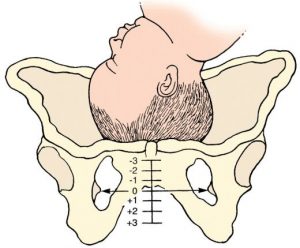Have you heard of the Bishop Score? Dr. Edward Bishop developed this measure of cervical readiness in 1964. It assesses five criteria to ascertain the likelihood of a successful induction, in women who are full term, where an induction might be necessary. Scores for each of the criteria range from 0 to 2 or 3, with a total maximum score of 12.
How does my doctor assign points?

The above table lays out each of the categories your provider will assess and how many points are assigned for each finding. Because your cervix must be assessed, a vaginal exam is necessary to ascertain your Bishop Score. It is important to remember that the Bishop Score is not the be-all-end-all. The information gathered from this assessment should be used in conjunction with your medical history and the health of your baby to develop a plan for delivery. If your provider hasn’t told you your Bishop score, you can ask for this assessment to be done.
What do you mean by those criteria?
- Dilation – This is a measure (in centimeters) of how open your cervix is. It is, arguably, the most important element of the Bishop Score.
- Effacement – This is a relative measurement of how thinned out your cervix is. 0% indicates a cervix that is normal and not thinned out yet, whereas 100% indicates a cervix that has completely thinned out.
 Station – This is where your baby’s head is in relation to the ischial spines (bony projections of the lower pelvis). Negative numbers indicate that your baby’s head is above these spines, zero is at the level of the ischial spines, and positive numbers indicate that the baby’s head is lower than the ischial spines.
Station – This is where your baby’s head is in relation to the ischial spines (bony projections of the lower pelvis). Negative numbers indicate that your baby’s head is above these spines, zero is at the level of the ischial spines, and positive numbers indicate that the baby’s head is lower than the ischial spines.- Consistency – A measure of the texture of your cervix. Firm means the cervix feels hard and rubbery (like the tip of your nose). Medium is a cervix that is compressible but not soft, and soft is a cervix that feels mushy.
- Position – Where the cervix is relative to the baby’s head and the mother’s pelvis.
Some providers may modify the original Bishop Score as follows:
+1 point for:
- presence of preeclampsia
- each previous vaginal delivery
-1 point for:
- >40 weeks gestation
- no previous vaginal deliveries
- preterm premature rupture of membranes (PPROM)
There is no evidence that these modifications provide for a better prediction than the original scoring system.
What does the Bishop Score mean?
Higher scores suggest that a cervix is more favorable for induction, whereas lower scores suggest that an induction is less likely to be successful.
- >8 – indicates that labor is likely to start spontaneously or soon. If an induction is necessary, it is more likely to be successful
- 6-7 – this is a gray area. Scores in this range are not good predictors for success of inductions
- <5 – indicates that an induction is less likely to be successful
Bear in mind that your Bishop Score merely serves as a predictor of the likelihood of an induction to be successful; it is not an absolute measure. Only your OB/GYN or midwife can counsel you as to the best way to proceed with the delivery of your baby.
Additional Readings
C is for Car Seats
D is for Delayed Cord Clamping
E is for Epidural
This post is for informational purposes only. It should not take the place of consultation with your healthcare professional.

